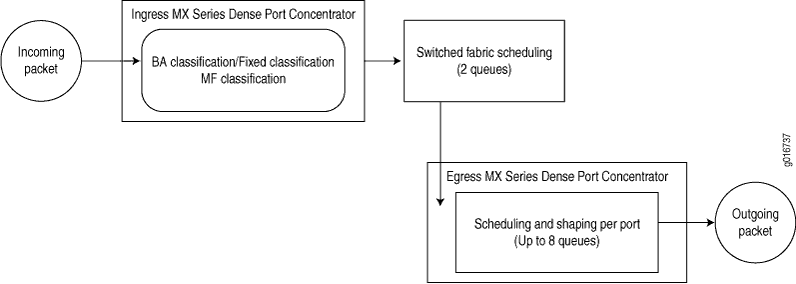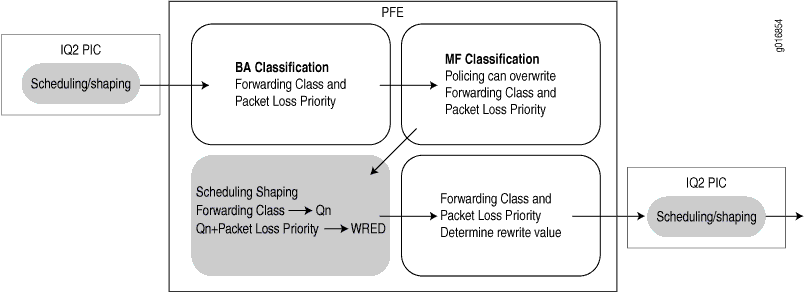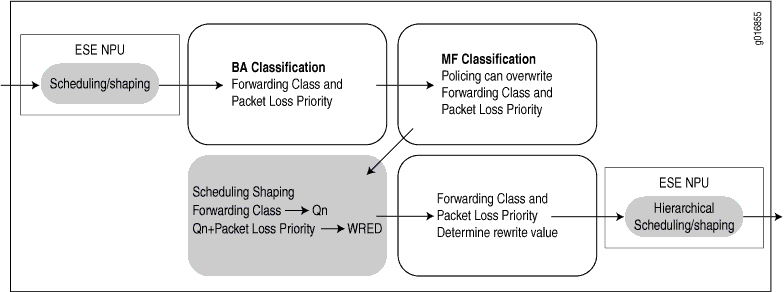Packet Flow on MX Series 5G Universal Routing Platforms
The CoS architecture for MX Series 5G Universal Routing Platforms, such as the MX960 router, is in concept similar to, but in particulars different from, other routers. The general architecture for MX Series routers is shown in Figure 1.Figure 1 illustrates packet flow through a Dense Port Concentrator (DPC).

All Layer 3 Junos OS CoS functions are supported on the MX Series routers. In addition, Layer 3 CoS capabilities, with the exception of traffic shaping, are supported on virtual LANs (VLANs) that span multiple ports.
MX Series routers can be equipped with Flexible PIC Concentrators
(FPCs) and associated Physical Interface Cards (PICs), Dense Port
Concentrators (DPCs), Modular Interface Cards (MICs), Modular Port
Concentrators (MPCs), or MPCs with associated MICs. In all cases,
the command-line interface (CLI) configuration syntax refers to FPCs,
PICs, and ports (type-fpc/pic/port).
The MX80 router is a single-board router with a built-in Routing Engine and one Packet Forwarding Engine, which can have up to four MICs attached to it. The Packet Forwarding Engine has two “pseudo” Flexible PIC Concentrators (FPC 0 and FPC1). Because there is no switching fabric, the single Packet Forwarding Engine takes care of both ingress and egress packet forwarding.
Fixed classification places all packets in the same forwarding class, or the usual multifield or behavior aggregate (BA) classifications can be used to treat packets differently. BA classification with firewall filters can be used for classification based on IP precedence, DSCP, IEEE, or other bits in the frame or packet header.
However, the MX Series routers can also employ multiple BA classifiers on the same logical interface. The logical interfaces do not have to employ the same type of BA classifier. For example, a single logical interface can use classifiers based on IP precedence as well as IEEE 802.1p. If the CoS bits of interest are on the inner VLAN tag of a dual-tagged VLAN interface, the classifier can examine either the inner or outer bits. (By default, the classification is done based on the outer VLAN tag.)
Internal fabric scheduling is based on only two queues: high and low priority. Strict-high priority queuing is also supported in the high-priority category.
Egress port scheduling supports up to eight queues per port using a form of round-robin queue servicing. The supported priority levels are strict-high, high, medium-high, medium-low, and low. The MX Series router architecture supports both early discard and tail drop on the queues.
All CoS features are supported at line rate.
The fundamental flow of a packet subjected to CoS is different in the MX Series router with integrated chips than it is in the M Series Multiservice Edge Router and T Series Core Router, which have a different packet-handling architecture.
The way that a packet makes its way through an M Series or T Series router with Intelligent Queuing 2 (IQ2) PICs is shown in Figure 2. Note that the per-VLAN scheduling and shaping are done on the PIC whereas all other CoS functions at the port level are performed on the Packet Forwarding Engine.

The way that a packet makes its way through an MX Series router is shown in Figure 3. Note that the scheduling and shaping are done with an integrated architecture along with all other CoS functions. In particular, scheduling and shaping are done on the Ethernet services engine network processing unit (ESE NPU). Hierarchical scheduling is supported on the output side as well as the input side.

